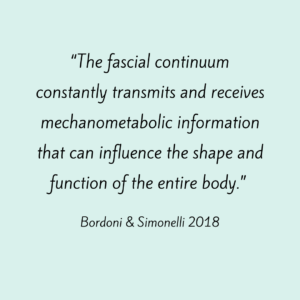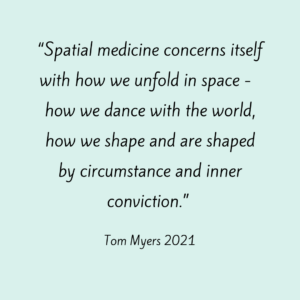Fascia: Revolutionizing our understanding of human health
- In Fascia

The fascial system is one of the most interesting systems in the human body. For a long time, it has been considered as important only in relation to its functions in movement, but recent research is revealing more about how it plays a much wider role for healing throughout all other systems in the body.
Fascia & the body
Fascia is a general term for a wide range of connective tissues in the body. Ligaments, tendons and other connective membranes in the body are made up of fascia. These components create a continuous three-dimensional internal network throughout the body, wrapping all muscles, bones, nerves, blood vessels and organs – connecting them and compartmentalizing them in functional ways. Through our movement and posture, fascia continually modifies itself and shapes our bodies in the way that is optimal for the types of activities we do.
Beyond its structural functions, fascial tissue serves many unique roles in healing and repair, as well as nutrition, communication, transport and detoxification, through all levels in the body from the largest structures down to the cellular level.

It is an integrating system, creating a space in which all other structures live and a medium through which they communicate and function together as a whole. Understanding fascia helps us gain a more holistic perspective of physical health. Even more interesting is the way that fascia is the medium through which mental, emotional and spiritual states affect our physical bodies.
Fascia & the mind
Fascia serves as a home for our nervous system, supporting and expanding its sensory and communicative functions within our bodies. Our mental and emotional states are functions of the nervous system, and our fascia responds directly to them. For example, when our nervous system senses potential danger in our environment, our fascia facilitates a whole-body protection response. All emotions create unique fascial responses and physical sensations in our bodies. In this way, our bodies physically showcase our emotional states to those around us, influencing the way we interact with the world. Experiencing strong emotions in response to environmental or social circumstances (like traumatic events) can have lasting effects on the way our fascia shapes our bodies. Long-term protection patterns held within our fascial system is one way in which our bodies hold trauma for us, and this can contribute to the development of physical pain and problems.
Fascia as a bridge
The way fascia connects and integrates our inner world brings to light new perspectives on the interconnectedness of the physical, mental, emotional and spiritual facets of our being. Traditionally, Eastern concepts of medicine have been teaching us about this, and modern scientific research about fascia is allowing Western medicine to catch up. The Eastern and Western concepts of health may seem on opposite ends of the spectrum at times, but fascia connects them in novel ways that show us that both approaches can coexist, and that their intelligent combination is often much more effective than either approach alone. The merging of all available beneficial treatment approaches is what integrative medicine aims to achieve. This is the future of healthcare.
A new approach
Through the work of fascia researchers and leaders in the field like Tom Myers, Dr Robert Schleip and the Stecco family, among others, new treatment concepts are emerging that help evolve outdated biomechanical models into a more applicable concept of spatial medicine – the physical aspects of medicine that can have profound effects on all levels of health. Applying these concepts in practical ways is a new frontier of physical medicine that is changing the way we work, and it is an exciting new field that continues growing as we keep discovering new things.

Many of my patients struggling with chronic pain or disability, and those who have concurrent mental or emotional challenges like depression, anxiety or a history of trauma, have found limited effect from conventional manual therapy approaches. Often, these methods actually worsened their pain and dysregulation. These types of patients, including those who are naturally highly sensitive or neurodivergent, benefit much more from gentler types of manual therapy that use more holistic approaches, and fascia research provides so much understanding and opportunity for developing these approaches.
Learning about fascia and how it creates a holistic picture of human health has changed my life and my work. It also changes how my patients heal and supports their capacity to heal themselves much better. I encourage anyone with an interest in health to explore more into this fascinating concept. Expanding our knowledge of fascia will widen our perspective of human health, and everything that influences us and is influenced by us. A more holistic approach to human health will pave the way for new medical approaches based on improving a person’s well-being as a whole, and helping people to thrive and not just survive in the world.
Image credits:
1 Whole Body: https://www.midwestholistichealth.com/services/whole-body
2 Fascia: https://sarahyounglmbt.com/fascia-the-tissue-that-binds/
3 Holistic Health: https://indianschoolofimage.com/2022/01/29/5-holistic-health-aspects-wellness-and-its-importance/
You may also like

